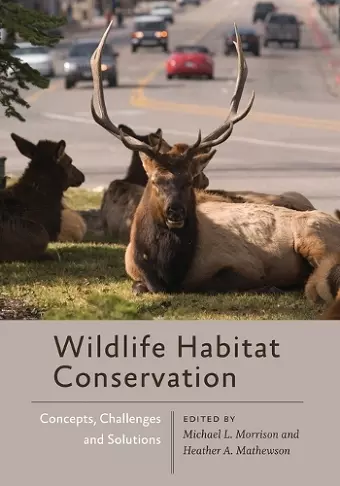Wildlife Habitat Conservation
Concepts, Challenges, and Solutions
Michael L Morrison editor Heather A Mathewson editor
Format:Paperback
Publisher:Johns Hopkins University Press
Published:16th Feb '21
Currently unavailable, and unfortunately no date known when it will be back
This paperback is available in another edition too:
- Hardback£64.00(9781421416106)

A book that emphasized the concept of wildlife habitat for a generation of students and professionals is now available to even more readers.
"Habitat" is probably the most common term in ecological research. Elementary school students are introduced to the term, college students study the concept in depth, hunters make their plans based on it, nature explorers chat about the different types, and land managers spend enormous time and money modifying and restoring habitats. Although a broad swath of people now have some notion of what habitat is, the scientific community has by and large failed to define it concretely, despite repeated attempts in the literature to come to meaningful conclusions regarding what habitat is and how we should study, manipulate, and ultimately conserve it.
Wildlife Habitat Conservation presents an authoritative review of the habitat concept, provides a scientifically rigorous definition, and emphasizes how we must focus on those critical factors contained within what we call habitat. The result is a habitat concept that promises long-term persistence of animal populations.
Key concepts and items in the book include:
• Rigorous and standard conceptual definitions of wildlife and their habitat.
• A discussion of the essential integration of population demographics and population persistence with the concept of habitat.
• The importance of carryover and lag effects, behavioral processes, genetics, and species interactions to our understanding of habitat.
• An examination of spatiotemporal heterogeneity, realized through fragmentation, disruption to eco-evolutionary processes, and alterations to plant and animal assemblages.
• An explanation of how anthropogenic effects alter population size and distribution (isolation), genetic processes, and species diversity (including exotic plants and animals).
• Advocacy of proactive management and conservation through predictive modeling, restoration, and monitoring.
Each chapter is accessibly written in a style that will be welcomed by private landowners and public resource managers at local, state, and federal levels. Also ideal for undergraduate and graduate natural resource and conservation courses, the book is organized perfectly for a one-semester class.
Published in association with The Wildlife Society.
A timely volume . . . A useful book for those interested in natural resources.
—Choice
An excellent contribution to the understanding of what habitat is and how to conserve it.
—Conservation Biology
In this very worthwhile book, the editors and chapter authors have accomplished the important task of setting forth a path to guide habitat management and conservation.
—Great Plains Research
The editors of this volume accomplished their goal of reaching a broad audience and providing this audience with an understanding of the factors affecting wildlife and their habitats. The book will be most useful for wildlife students, but will also have immense utility for managers seeking to understand and address emerging habitat threats, and for researchers aiming to broaden their perspectives on the variety of factors influencing habitat.
—Landscape Ecologist
Taken as a whole, this collection of chapters will provide a benchmark for understanding how we are to understand the global consequences of human consumption.
—Quarterly Review of Biology
ISBN: 9781421439914
Dimensions: 254mm x 178mm x 12mm
Weight: 431g
200 pages